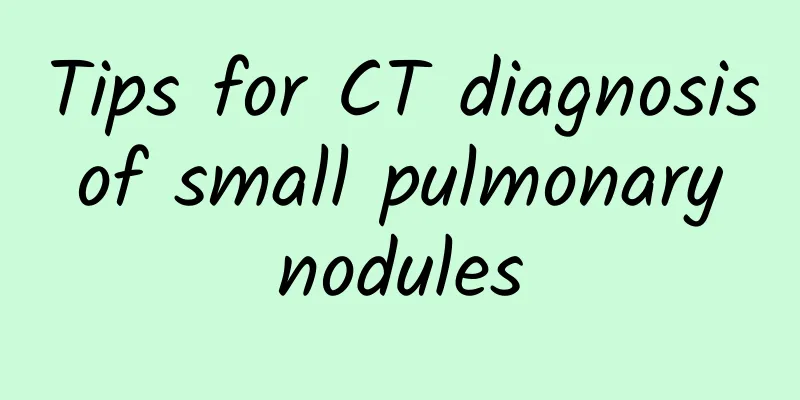Tips for CT diagnosis of small pulmonary nodules

|
Small lung nodules are small focal, rounded, and imaging shadows with increased density. Generally, such small lung nodules can be single or multiple, without atelectasis, hilar enlargement, and pleural effusion. And small lung nodules are not equal to early lung cancer. When there are many small nodular lesions in the lungs, benign ones include inflammatory pseudotumors, tuberculomas, fungal infections, etc., and malignant ones include primary lung cancer or intrapulmonary metastatic cancer. Most nodules are benign, and some gradually become malignant over time. Then the more effective examination is CT examination. Through this examination, small lung nodules can be found, and the nature of the nodules can be judged. Whether the nodules are benign or malignant, most of them are benign lesions, but we must also pay great attention to it, because there is also a certain probability of early lung cancer. When there are small lung nodules in CT examination, we must follow the doctor's advice and check them regularly. At this stage, there are still many people who do not know enough about the CT diagnosis of small lung nodules. The following is the popularization of knowledge related to the CT diagnosis of small lung nodules, hoping to help people understand the corresponding knowledge. 1. The significance of CT in diagnosing small pulmonary nodules (1) Determine the nature of pulmonary nodules: CT examination can observe the morphology of pulmonary nodules more clearly. The malignant tumor morphology of pulmonary nodules has the following characteristics, such as irregular nodule margins, short hair features, irritation protrusions, vesicle signs, vascular bundle signs, pleural traction signs, etc. The benign morphology of pulmonary nodules has the following characteristics, such as no blood vessels in the lesions, smooth nodule margins, and regular shapes. Through enhanced CT scanning, if the CT value changes between 20-60HU before and after the scan, it indicates that the nature of the pulmonary nodules is malignant and needs to be confirmed immediately and then removed. (2) Improve the diagnostic accuracy of pulmonary nodules: With the continuous advancement of clinical imaging technology, CT examination has gradually been applied in clinical diagnosis, which has a relatively obvious effect on the diagnosis of pulmonary nodules, can better improve the diagnostic accuracy of pulmonary nodules, and can also accurately observe the size, shape, density and other characteristics of the patient's lesions, providing a more accurate basis for clinical treatment. In addition, CT examination time is relatively short, the operation is relatively simple, and the images presented are also clearer. (3) Providing accurate basis for follow-up treatment: CT scans are used to examine small lung nodules. For those with unclear features, follow-up is required. If the nodules are at risk of enlargement after two months of regular follow-up, surgical resection is required immediately. If the diameter remains unchanged, follow-up is continued. For patients with malignant nodules, the attending physician will formulate the best treatment plan based on the results of the CT scan. **2. ** CT examination method of small lung nodules CT examination has great diagnostic significance for small lung nodules, especially those smaller than 1 cm. Therefore, CT examination plays a vital role in improving the diagnosis rate of early lung cancer. At present, four types of chest CT scans are usually used in the diagnosis of small lung nodules: (1) Conventional CT plain scan: This is the most commonly used CT plain scan in clinical practice. This type of examination has relatively low requirements for equipment inspection. The slice spacing of ordinary CT plain scans is 8-10mm, so the scanning speed is relatively fast and small lung nodules can be easily found. However, due to the wide slice spacing, small lung nodules are easily missed, especially for small lung nodules smaller than 10mm. The incidence of early lung cancer smaller than 10mm is increasing. (2) High-resolution thin-slice CT plain scan: This is a CT examination with a relatively small slice spacing. Generally, a slice spacing of 5mm is called a thin-slice CT. In order to achieve a smaller slice spacing, a more advanced high-resolution CT examination is required. Smaller slice spacing, higher-resolution algorithms and larger matrices will bring more diagnostic information. At present, high-resolution thin-slice CT examinations are more commonly used for small lung nodules, which can better see the finer structures of the lungs. (3) 3D reconstruction of pulmonary nodules: Many hospitals offer diagnostic examinations for pulmonary nodules. This type of CT examination has a smaller slice spacing, generally less than 2 mm, and has a higher resolution for pulmonary nodules. It also has many advantages: ① It can detect the density of pulmonary nodules more accurately, and can determine whether the pulmonary nodules are pure ground glass nodules, mixed ground glass nodules, or solid nodules based on the ratio. ② It can observe the relationship between pulmonary nodules and blood vessels, and determine whether the pulmonary nodules are benign or malignant based on the blood supply. ③ It can calculate the volume of pulmonary nodules and the doubling time of nodules, which is also an important basis for judging the nature of nodules. ④ It can be imaged by computer, so that the morphology, edges, and other contents of pulmonary nodules can be better and more intuitively seen. (4) Low-dose spiral CT examination: This type of CT examination has a relatively small radiation dose and is more suitable for people who need physical examinations and short-term examinations. **3. ** When treating small lung nodules, you must avoid these misunderstandings (1) Failure to treat lung nodules correctly: When patients are diagnosed with lung nodules, they may easily become overly frightened. They must take it seriously and not panic or be careless. They must follow the doctor's instructions so that they can take the disease seriously. (2) Failure to follow the doctor's instructions for examination: If the patient does not provide an accurate medical history and smoking history, the physical examination is not detailed enough, the sputum exfoliative cytology examination is not taken seriously, there is blood in the sputum but no relevant examination is done, or the sputum is of poor quality or causes a false positive result, it is easy to affect the diagnosis of their own disease. Therefore, patients must follow the doctor's instructions and strictly implement the corresponding examination plan. (3) Unreasonable follow-up frequency: Some patients do not strictly follow the scientific and reasonable follow-up frequency during the follow-up process. They only remember to go to the hospital for follow-up examinations when more serious symptoms appear. To avoid this situation, it is necessary to insist on regular follow-up at the hospital to prevent the condition from worsening and leading to more serious consequences. 4. Precautions for CT examination of small lung nodules When patients undergo CT scans of small lung nodules, they need to remove all metal objects from their bodies to avoid artifacts caused by radiation interference, which will greatly interfere with the image of normal human tissue. (2) Do not perform any gastrointestinal contrast examinations one week before the examination to prevent artifacts caused by barium sulfate, which will greatly interfere with the image of surrounding normal organs and tissues. (3) Patients who need to undergo enhanced CT examinations and those who are allergic to iodine should inform medical staff in advance to prevent severe allergic reactions during the examination. |
<<: National Nutrition Week | Food and Nutrition Tips
>>: Guidelines for the prevention and early detection of stroke
Recommend
Can pregnant women drink white radish water?
White radish is a common vegetable in daily life....
What should I do if a woman has a beard at the corner of her mouth?
There is a big difference between men and women. ...
What are the symptoms of itchy palms in women?
Female friends do not pay much attention to itchy...
Brain Health Month Science Popularization Series丨A man suffered from repeated headaches and unsteady walking, and the real culprit turned out to be a brain glioma!
Uncle Li, 53, was usually in good health. But six...
Original research drugs, that's what it is
This is the 5262nd article of Da Yi Xiao Hu In De...
What is the reason for transparent floating objects in front of the eyes? Why can I see many transparent small dots?
Sometimes we often feel that we can see some smal...
How many days does it take to detect successful conception?
Some people have very obvious pregnancy reactions...
Pictures of episiotomy wound healed
During the delivery process, most mothers who del...
What are the benefits of push-ups for girls
We all know that push-ups can help you lose weigh...
What are the solutions for sagging breasts in women?
Every woman wants to have firm breasts, which wil...
Dysmenorrhea is divided into 3 levels and 6 dietary treatments can relieve it
Mild level 1 Mild level 1: Obvious lower abdomina...
Is it dangerous to faint from menstrual cramps?
Most girls will start menstruating around the age...
What should I do if my period is delayed and my vaginal discharge increases?
Period, also known as menstruation. The ovaries h...
Pain in the left fallopian tube during menstruation
Menstruation is a normal physiological cycle for ...
At what stage can the placenta be delivered?
In fact, pregnant women usually give birth to bab...









